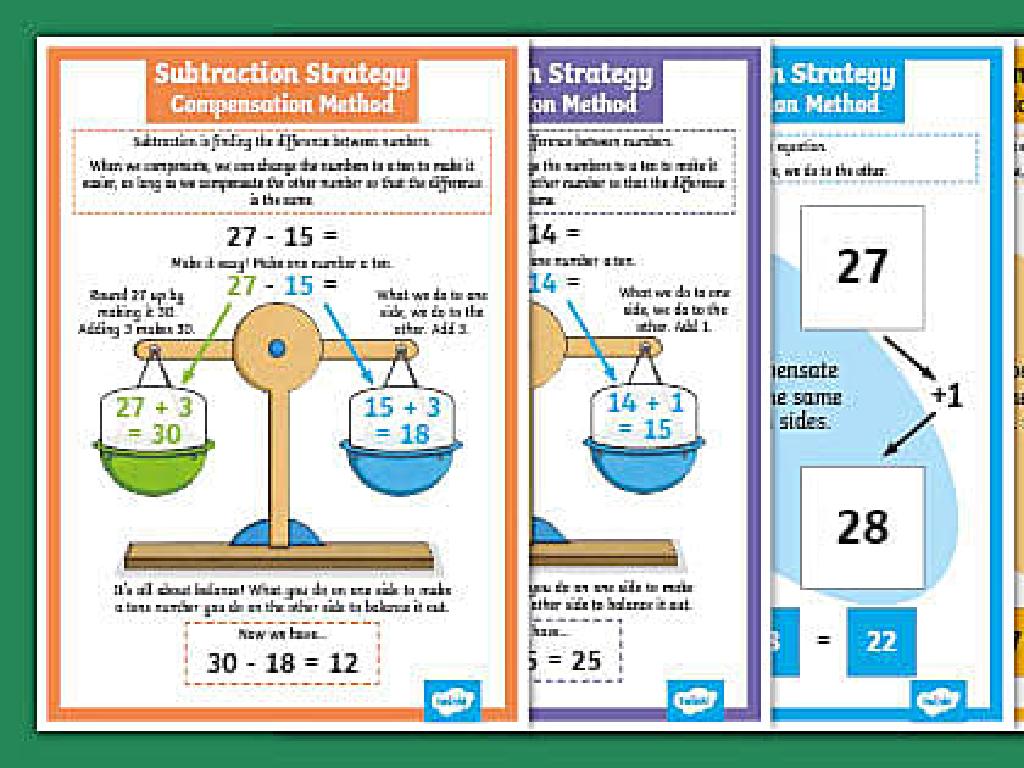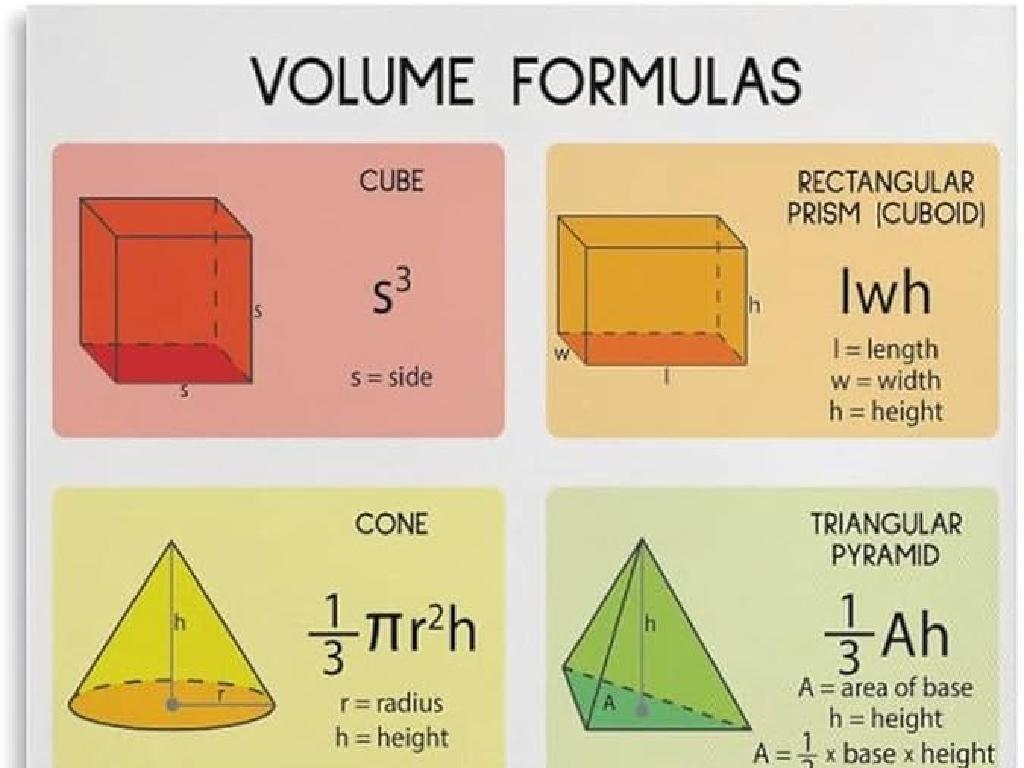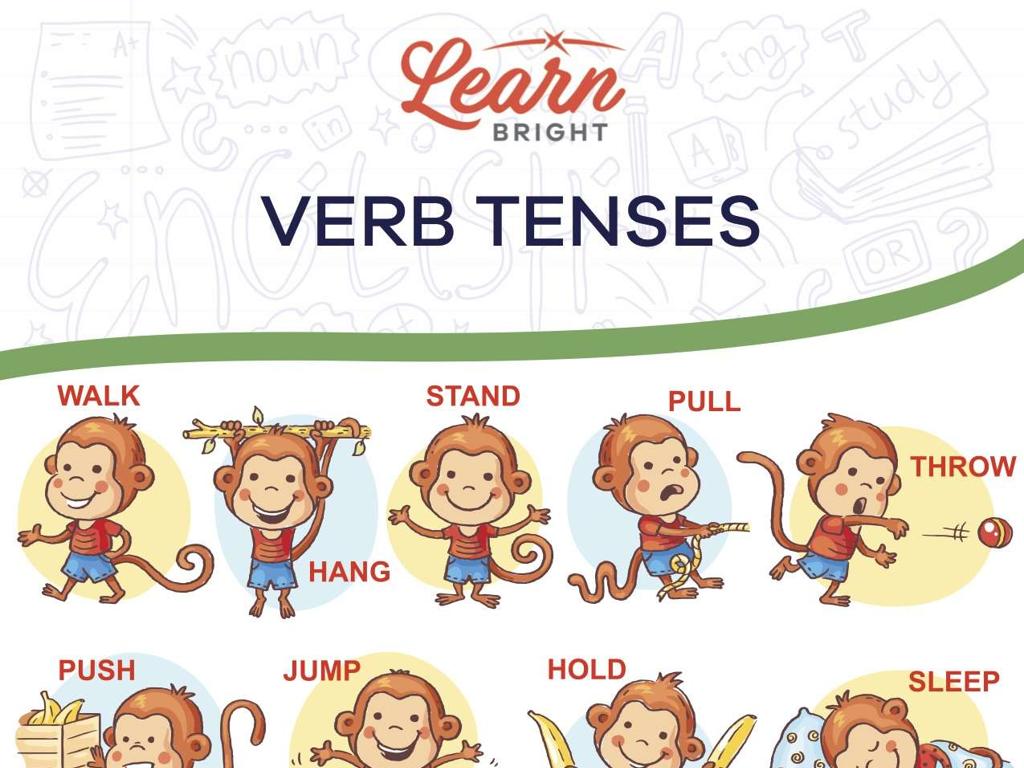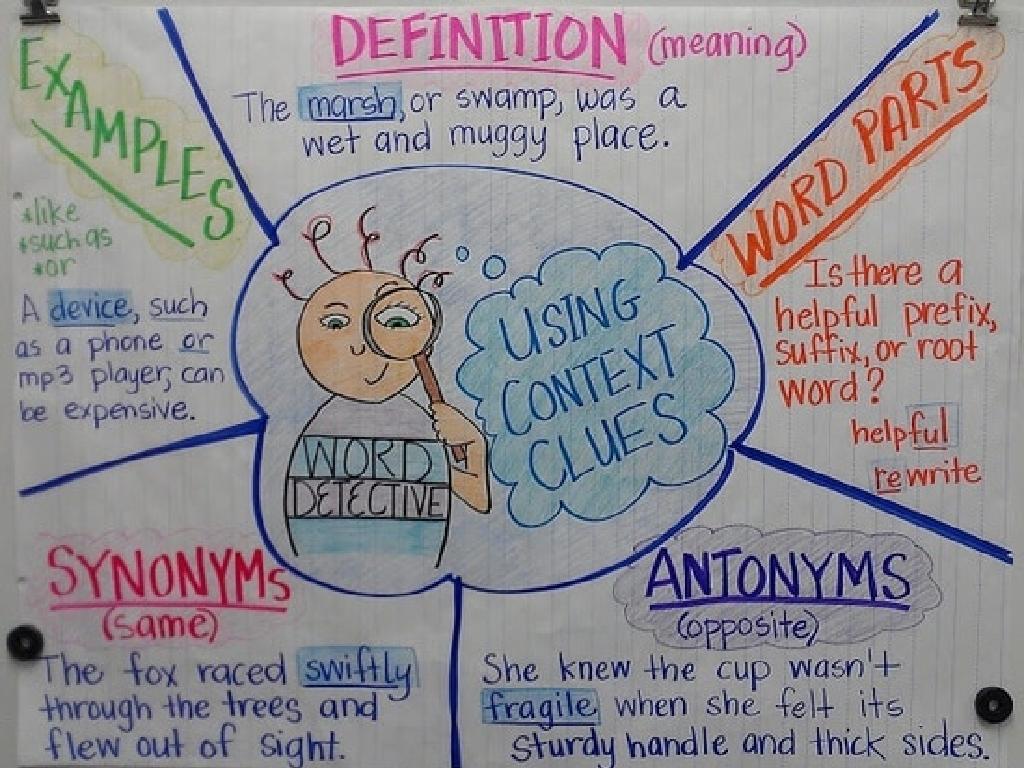Identify And Correct Errors With Plural And Possessive Nouns
Subject: Language arts
Grade: Fifth grade
Topic: Nouns
Please LOG IN to download the presentation. Access is available to registered users only.
View More Content
Welcome to Nouns!
– Define Nouns
– A noun is a person, place, thing, or idea.
– Singular vs Plural Nouns
– Singular noun: one item, Plural noun: more than one item.
– Possessive Nouns
– Shows ownership, e.g., ‘dog’s bone’ means the bone belongs to the dog.
– Correcting Errors
– We’ll learn to spot and fix mistakes with plurals and possessives.
|
This slide introduces the concept of nouns to the students, explaining that nouns can be a person, place, thing, or idea. It distinguishes between singular and plural nouns, emphasizing the change in form to denote quantity. The slide also introduces possessive nouns, which indicate ownership or association. The final point focuses on teaching students to identify and correct common errors in the use of plural and possessive nouns, such as adding ‘s to make a noun plural or forgetting the apostrophe in possessive nouns. Engage the class with examples and encourage them to come up with their own. Prepare exercises where students can practice identifying and correcting these errors.
Singular and Plural Nouns
– What are Singular Nouns?
A singular noun names one person, place, thing, or idea.
– What are Plural Nouns?
A plural noun names more than one person, place, thing, or idea.
– Rules for Plural Nouns
Most nouns add ‘s’ or ‘es’, but there are special rules too.
– Examples: Singular to Plural
Child becomes children, mouse becomes mice, and fox becomes foxes.
|
This slide introduces the concept of singular and plural nouns to the students. Begin by explaining that a singular noun refers to one single entity, while a plural noun refers to more than one. Emphasize the basic rule of adding ‘s’ or ‘es’ to make most nouns plural, but also highlight that English has many irregular nouns that do not follow this rule. Provide clear examples to illustrate the transformation from singular to plural, including both regular and irregular forms. Encourage students to think of their own examples and to understand that mastering these rules will help them write correctly and clearly.
Regular vs. Irregular Plurals
– Understanding Regular Plurals
– Regular plurals add ‘s’ or ‘es’ (e.g., cats, boxes)
– Exploring Irregular Plurals
– Irregular plurals change form (e.g., mice, children)
– Regular and Irregular Plurals Examples
– Compare ‘dog’ to ‘dogs’ and ‘man’ to ‘men’
– Class Activity: Identify Plurals
|
This slide introduces the concept of plural nouns, focusing on the difference between regular and irregular plurals. Regular plurals typically involve adding ‘s’ or ‘es’ to the end of the word, while irregular plurals change the word form entirely. Provide clear examples of both types to help students recognize patterns. For the class activity, prepare a worksheet with a mix of singular nouns for students to convert into plurals, ensuring a balance between regular and irregular forms. Encourage students to explain their reasoning for each transformation, reinforcing their understanding of the rules and exceptions in pluralization.
Mastering Possessive Nouns
– Definition of possessive nouns
Possessive nouns show ownership, like ‘dog’s leash’ or ‘teacher’s book’.
– Forming possessive nouns
Add ‘s to singular nouns, even if they end in s, like ‘boss’s’. For plural nouns ending in s, just add an apostrophe, like ‘dogs’.
– Apostrophes in possessive nouns
Use apostrophes to show who owns something. Remember, for plural nouns not ending in s, add ‘s, like ‘children’s toys’.
– Examples of possessive nouns
Singular: ‘cat’s whiskers’. Plural: ‘cats’ whiskers’ for multiple cats.
|
This slide introduces possessive nouns, which indicate ownership or belonging. Start by explaining the concept with simple examples. Then, demonstrate how to form possessive nouns from both singular and plural nouns, emphasizing the placement of the apostrophe. Provide clear examples for each case, including exceptions to the rules. Encourage students to create their own examples and correct common mistakes. This will help them understand how to use possessive nouns in their writing, which is a key skill in Language Arts.
Common Errors: Plurals and Possessives
– Avoiding plural noun mistakes
– Plurals usually end in ‘s’ but watch out for irregular forms!
– Avoiding possessive noun mistakes
– Possessives show ownership with ‘s, but don’t confuse with plurals!
– How to correct errors in sentences
– Read sentences carefully to find and fix noun errors.
– Practice: Spot and fix errors
– Use example sentences to apply what you’ve learned.
|
This slide aims to help students identify and correct common mistakes with plural and possessive nouns. Emphasize the difference between simply making a noun plural versus showing ownership. Provide clear examples of both regular and irregular plural forms, and demonstrate how an apostrophe is used to indicate possession. During practice, encourage students to look for context clues that indicate whether a noun should be plural or possessive, and to correct sentences with common errors. The activity should involve students working on example sentences to apply these rules, reinforcing their understanding through practical application.
Let’s Practice: Plural & Possessive Nouns
– Activity: Forming plurals and possessives
– Activity: Sentence correction on board
– Group Work: Write sentences using nouns
– Collaborate to create sentences with both plural and possessive nouns.
– Share and review as a class
– Discuss as a group and learn from each other’s examples.
|
This slide introduces interactive classroom activities focused on plural and possessive nouns. Begin with an activity where students create plural and possessive forms of given nouns. Then, move on to correcting sentences written on the board, emphasizing common mistakes. For group work, students will write their own sentences using plural and possessive nouns, which encourages collaboration and application of the concepts. Conclude with a sharing session where students present their sentences and the class reviews them together. This will reinforce their understanding and provide immediate feedback. Possible activities: 1) Students list items in the classroom and write their plural forms. 2) Create possessive forms of nouns related to family members. 3) Correct sentences with misplaced apostrophes. 4) Write a short paragraph using plural and possessive nouns from a list.
Class Activity: Noun Hunt
– Find classroom items for noun forms
– Write plural and possessive forms
– Example: ‘desk’ becomes ‘desks’ (plural), ‘desk s’ (possessive)
– Share findings with the class
– Discuss noun form importance
– Correct forms clarify meaning and show ownership
|
This activity is designed to help students understand the concept of plural and possessive nouns through a practical and interactive approach. Have the students look around the classroom and select various items. Then, they should write down the plural form (adding ‘s’ or ‘es’, or changing ‘y’ to ‘ies’) and the possessive form (adding ‘s or just an apostrophe for plural nouns ending in ‘s’). Afterward, students will share their examples with the class, which will help reinforce their understanding through peer learning. Finally, lead a discussion on why using the correct noun forms is crucial for clear communication. Emphasize that proper use of plurals and possessives can change the meaning of sentences and is key to showing ownership or quantity in writing.
Wrapping Up: Plurals and Possessives
– Review of plural and possessive nouns
– Homework: Complete the noun worksheet
– Worksheet focuses on identifying and using plural and possessive nouns correctly
– Remember: Consistent practice is key
– Bring any questions to next class
|
As we conclude today’s lesson, remind students of the key points about plural and possessive nouns. Emphasize the importance of recognizing the difference between them and using them correctly in sentences. For homework, assign the provided worksheet which will reinforce today’s learning by having students practice forming and using plural and possessive nouns. Encourage students to practice regularly as this will help solidify their understanding. Let them know they can bring up any questions or difficulties they encounter during the next class for clarification.






